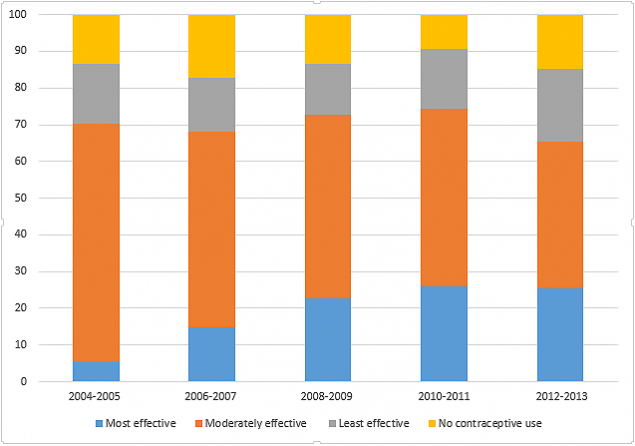Repeat Teen Births
The Number of Teen Mothers Having a Repeat Birth Before Age 20 Has Declined Since 2004.
However, in 2015, More Than 38,000 US Teens Had a Repeat Birth.
The good news:
- In 2015, 1 in 6 births to teens aged 15 to 19 years was a repeat birth—down from 1 in 5 in 2004.
- The proportion of teen mothers using the most effective methods* of reversible contraception (IUDs or implants), also known as long-acting reversible contraception (LARC), increased from 5.3% to 25.3%.
Trends and Distribution of Postpartum Contraception Method Use* Among Teens aged <20 years—Pregnancy Risk Assessment Monitoring System (PRAMS), 5 states, † 2004–2013.

The not-so good news:
- While about 25% of teen mothers used the most effective methods of contraception (implants or IUDs) in 2013, 33% used a least effective method (mostly condoms alone) or no contraception at all.
Distribution of Postpartum Contraception Method Use* Among Teens Aged <20 Years—Pregnancy Risk Assessment Monitoring System (PRAMS), 31 Sites, 2013

Access to the full range of contraceptive methods after birth, especially moderately and most effective contraception, is critical for preventing repeat teen births.
- CDC and other federal partners are working to prevent all teen births, including repeat teen births.
- State and community-based prevention efforts can make a difference. They can support:
- Postpartum women’s contraceptive needs and choices, including immediate postpartum insertion of the implant or IUD, also known as long-acting reversible contraception (LARC) [PDF – 234KB].
- Programs that provide support services to parenting teens.
For more information about repeat teen births and what state and community-based organizations can do to support the prevention of repeat teen pregnancy, read the full “Trends in Repeat Births and Use of Postpartum Contraception Among Teens—United States, 2004–2015” article.
Additional resources for state and community-based organizations include:
* Methods categorized by effectiveness, as determined by the percentage of females who experience pregnancy during the first year of typical use as the following: most effective (contraceptive implant and intrauterine device, also known as Long-acting reversible contraception (LARC), (<1%); moderately effective (oral contraceptive pill, an injectable [e.g., Depo-Provera], birth control patch, and vaginal ring) (6%–10%); and least effective (condom, diaphragm, cervical cap, contraceptive sponge, rhythm method/natural family planning, the morning after pill, withdrawal, and other responses that could not be categorized to a more effective category) (>10%); also includes measure of teen mothers who report no postpartum contraceptive use.
† Arkansas, Michigan, Nebraska, Oregon, and Rhode Island.
- Page last reviewed: June 28, 2017
- Page last updated: June 28, 2017
- Content source:


 ShareCompartir
ShareCompartir